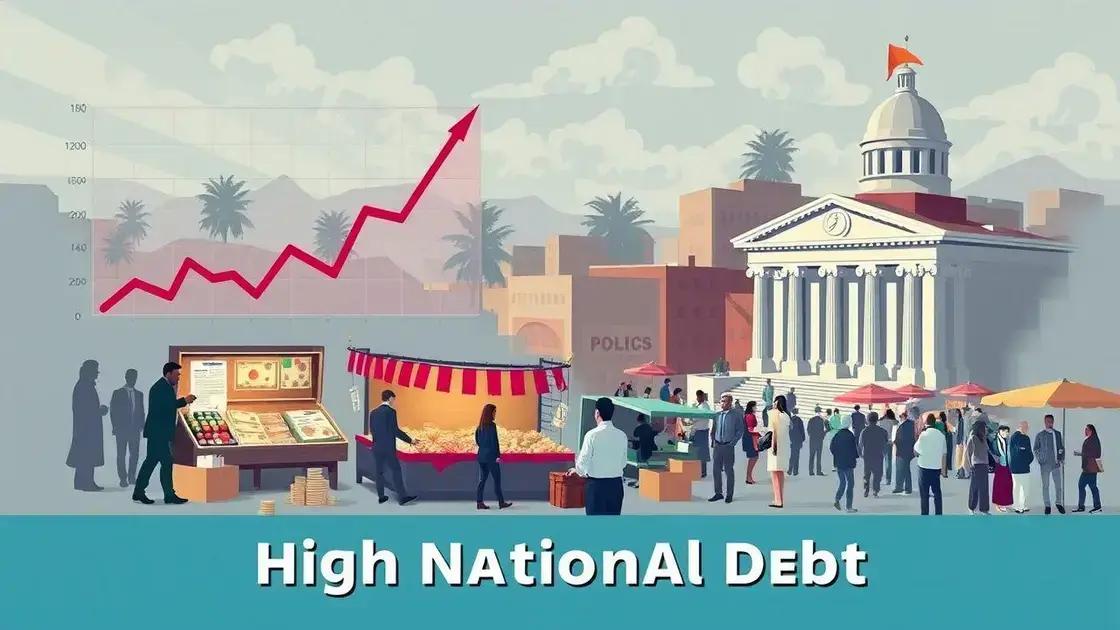Global debt surpasses GDP: what it means for us

Global debt surpasses GDP, leading to economic instability, increased taxes, and reduced public spending, while individuals can respond by improving financial literacy and supporting local economies.
Global debt surpasses GDP, a concerning trend that prompts many to question the stability of our financial systems. What does this really mean for our daily lives and future economies? Let’s dive into the details.
Understanding global debt levels
Understanding global debt levels is crucial in today’s financial landscape. As nations grapple with increasing borrowing, it’s essential to comprehend what these figures mean for the world economy. This section will explore the factors contributing to rising debt and its implications.
Factors Contributing to Rising Debt
Many elements influence the national and global debt levels. Economic conditions, government policies, and global events create a complex web that determines how much debt a country might take on. Some reasons include:
- Economic downturns that necessitate increased borrowing.
- Government investments in infrastructure and social programs.
- Interest rates affecting government borrowing costs.
Moreover, as countries expand their economies, they often resort to borrowing to fuel growth. This creates a cycle where debt levels rise despite efforts to manage them.
The Impact of Debt Levels
Rising debt can lead to various consequences for nations and their citizens. It can affect economic stability, leading to uncertainty in job markets and investments. With increasing debt, countries might face:
- Higher taxes to cover repayment costs.
- Reduction in public spending on essential services.
- Increased risk of economic crises if debt becomes unsustainable.
Additionally, understanding how these factors interplay is vital for anticipating future economic scenarios. As debt continues to rise globally, we must keep a close eye on its trajectory and its potential effects.
How GDP is measured

Understanding how GDP is measured helps us grasp the health of an economy. Gross Domestic Product (GDP) represents the total value of all goods and services produced in a country over a specific period. By examining this figure, we can assess economic growth or contraction.
Methods of Measuring GDP
There are three main approaches to measuring GDP: the production approach, the income approach, and the expenditure approach. Each method provides a unique perspective on economic activity. Here is a brief overview:
- Production Approach: This method calculates GDP by adding up the value of all goods and services produced.
- Income Approach: Here, GDP is determined by summing the incomes earned by households and businesses, including wages and profits.
- Expenditure Approach: This approach measures GDP by adding all expenditures made in the economy, such as consumption, investment, and government spending.
While each method offers insights, the expenditure approach is the most widely used, as it helps track where money is being spent in the economy. Understanding these methods allows us to better analyze how different sectors contribute to overall economic performance.
GDP Adjustments
It’s important to note that GDP figures are often adjusted for inflation, leading to a measure called real GDP. This adjustment helps provide a clearer picture of an economy’s growth by removing the effects of price changes. Policies and external factors can also influence these figures, making it necessary to look beyond numbers alone.
As we continue to explore economic conditions, knowing how GDP is measured will help us identify trends and make informed decisions. The interplay of various sectors within the economy can reveal much about future growth and stability.
The relationship between debt and GDP
The relationship between debt and GDP is a critical aspect of economic analysis. Understanding how these two elements interact can reveal much about a country’s financial health. When debt rises, it often reflects increased borrowing, which can spur economic activities.
Understanding the Debt-to-GDP Ratio
The debt-to-GDP ratio is a key indicator that compares a country’s total debt to its GDP. This ratio gives insights into how manageable a country’s debt levels are compared to its economic output. A high debt-to-GDP ratio may indicate that a country is over-leveraged, which can be a warning sign for investors.
- A ratio above 100% signals that a country owes more than it produces.
- A lower ratio suggests higher economic stability and less risk to investors.
- This ratio helps governments evaluate their fiscal policies and economic strategies.
While a certain level of debt can be beneficial for growth, excessive debt can lead to economic strain. Countries must balance their borrowing with sustainable economic output to maintain stability.
Implications of High Debt Levels
High debt levels compared to GDP can lead to various challenges for nations. It may result in reduced governmental capacity to spend on public services or investments. Additionally, high debt can lead to:
- Increased taxes as the government seeks to manage repayment.
- Interest rate hikes to attract investors to national bonds.
- Potential economic crises if investors lose confidence.
Therefore, a sound understanding of the relationship between debt and GDP is essential for making informed economic decisions. Policymakers must monitor these dynamics closely to foster a sustainable financial environment.
Impacts of high debt on economies

High levels of debt can significantly impact economies. As nations accumulate more debt, they face various challenges that can affect their growth and stability. This section explores the various ways in which high debt levels can influence national and global economies.
Economic Growth Constraints
One major consequence of high debt is the limitation it places on economic growth. When a country spends a large portion of its budget on interest payments, less funding is available for essential services and investments. This can lead to:
- Reduced public spending on infrastructure and education.
- Increased taxes, which can stifle consumer spending.
- Lower business investments due to uncertainty about future costs.
As a result, economic potential is not fully realized, and growth may stagnate.
Increased Risk of Crises
High debt levels also elevate the risk of financial crises. Investors may become wary of lending to highly indebted countries, leading to higher interest rates. In extreme cases, nations may default on their obligations, resulting in:
- Severe economic downturns.
- Loss of investor confidence.
- Potential for recession or economic collapse.
A nation’s credit rating may decline, making future borrowing both more difficult and expensive. These crises can have ripple effects across global markets, leading to wider economic instability.
Social Consequences
The impacts of high debt extend beyond economic numbers. Citizens may face increased taxes and reduced public services, leading to a lower quality of life. High debt can also result in:
- Strain on social programs that support the most vulnerable.
- Declining public trust in government.
- Increased unrest or protests as citizens respond to financial hardship.
Understanding the diverse consequences of high debt is crucial for policymakers aiming to create sustainable economic strategies. Addressing these issues proactively can help build a more resilient economy.
Future trends in global debt
Future trends in global debt are increasingly important to monitor, as they can influence economic stability worldwide. With rising debt levels across many countries, it’s critical to look at potential developments that may shape the financial landscape.
Continued Increase in Debt Levels
Many experts predict that global debt will continue to rise in the coming years. Factors contributing to this trend include:
- Increased government spending: As nations invest in infrastructure and social programs, they often rely on borrowing.
- Economic recovery: In the post-pandemic world, many countries will use debt to stimulate growth and recovery.
- Low interest rates: With borrowing costs remaining low, governments feel encouraged to take on more debt.
This upward trajectory may lead to new challenges for managing debt sustainably.
Shift Towards Green Financing
A notable trend is the shift towards green financing. More countries are focusing on sustainable development and environmental projects, often funded through green bonds. This can influence future debt markets significantly, as investors become more interested in financing initiatives that support sustainability.
By investing in green technologies, nations can potentially generate economic returns while addressing climate change. This dual benefit makes green financing an attractive option for future debt options.
Emergence of Digital Currencies
Another trend is the rise of digital currencies and blockchain technology, which could impact global debt. Central banks around the world are exploring digital currencies that may lead to:
- Increased efficiency: Digital currencies can streamline transactions and reduce costs.
- Enhanced monetary policy: Central banks may use these tools to better manage inflation and deflation.
- Broader financial access: Digital currencies could provide access to financial services in underserved communities.
As these technologies evolve, their influence on how countries manage debt may also change.
What individuals can do in response

As global debt continues to rise, individuals can take proactive steps to respond effectively to economic challenges. Understanding how to navigate this landscape is essential for personal and community well-being.
Educate Yourself on Financial Literacy
One of the first steps individuals can take is to improve their financial literacy. This knowledge helps in making informed decisions about spending, saving, and investing. Key areas to focus on include:
- Understanding budgeting: Create a budget to track income and expenses.
- Learning about credit: Understand credit scores and how they affect loans.
- Investment basics: Learn how to invest wisely to build wealth over time.
By enhancing financial knowledge, individuals can better prepare for economic uncertainties.
Advocate for Responsible Policies
Individuals can also play a role in advocating for responsible fiscal policies. Engaging with local representatives and advocating for:
- Transparency in government spending: Demand clear plans on how debt is managed.
- Sustainable economic practices: Support initiatives that promote economic growth without excessive borrowing.
- Community investment: Promote programs that enhance local economic opportunities.
Active participation in civic discussions can lead to positive changes in debt management at a community level.
Support Local Economies
Supporting local businesses is another effective way individuals can respond to high national debt. By spending within the community, individuals can help foster economic stability. This can be achieved by:
- Shopping locally: Choose local stores over large chains when possible.
- Investing in community projects: Seek out opportunities to invest in local enterprises.
- Participating in community events: Engage with local markets and fairs to strengthen connections.
Through these actions, individuals contribute to a robust local economy, which can mitigate the broader impacts of national debt.
In summary, understanding the complexities of global debt is crucial for individuals and nations alike. As debt levels rise, individuals can play an active role by improving their financial literacy, advocating for responsible policies, and supporting their local economies. By taking these steps, we can contribute to a more stable economy and potentially mitigate the impacts of high debt on our communities. Embracing these proactive approaches prepares us to navigate the financial challenges ahead.
FAQ – Frequently Asked Questions About Global Debt
What is the relationship between debt and GDP?
The relationship between debt and GDP is vital as it helps assess a country’s financial health. A high debt-to-GDP ratio can signal that a country may struggle to manage its debt.
How can individuals respond to rising global debt?
Individuals can respond by improving their financial literacy, advocating for responsible fiscal policies, and supporting local businesses to strengthen their community’s economy.
What are the potential impacts of high global debt?
High global debt can lead to economic growth constraints, increased risk of financial crises, and social consequences like reduced public services.
Why is it important to support local economies?
Supporting local economies helps foster community resilience and reduces reliance on national trends, mitigating the adverse effects of high debt on local communities.






